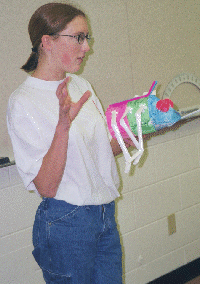I've got that Geometry Bug!
A Day in the Life of My Bug by Frances
My bug’s name is CylinderProbosciusHepitere
or for short, Fred. Cylinder because its main shape is a cylinder, Proboscius
because this is the tube in it’s mouth, and Hepitere because that is the Latin
name for bug.
My bug is very geometrical. The flexible
proboscis is a long cylinder and so are the antennas on top of its head. The
tubes that run down its back are cylinders and they allow messages from the
antenna such as sounds and smell get to the other organs and limbs in the body
such as the brain and the legs. My bugs eyes are the same as fly’s eyes they
are small squares joined together so Fred sees many images at once so he can
see predators from many different angles at once. When you look at Fred from
side on you will notice that his head is a triangle shape. Actually it is a
triangular prism. His head is this shape so his eyes are higher than his mouth
like most other bugs. The CylinderProbosciusHepitere has long flexible legs
that enable him to maneuver easily around. The legs are cylinder shapes so they
are very strong. In bugs and many other animal species the more joints in the
legs, the more flexible they are. The CylinderProbosciusHepitere has, like most
bugs, only three segments in each of his usual six legs, three on either side
coming from his thorax and abdomen.
Fred would live on the floor of a jungle in
between the rocks, plants flowers and other bugs. His bright colours allow him
to camouflage with the other tropical species. In each insect there are three
main parts, the thorax, the abdomen and the head. I decided to make each one of
these a different colour so he would look more attractive. Fred would normally
have one home with many other bugs such as himself living in a large colony
like ants in a hive they build themselves. The hive is built just under the
surface of the ground using twigs, sticks, mud and leaves all found locally, a
bit like how bees and many other species build their own homes. This house of
there’s would have about 1000 CylinderProbosciusHepitere living in it and would
be very crowded. In size it would be about 2.5 metres squared.
Every day it the same for my bug. It gets up
after the sun has risen because despite its excellent vision it can’t see in
the dark. Then it scavenges the forest ground for food to eat and food to take
back to the queen CylinderProbosciusHepitere who spends all day in the hive
like the queen bee. The CylinderProbosciusHepitere is a vegetarian and like the
butterflies drinks the nectar out of plants and flowers that grow low to the
ground because the CylinderProbosciusHepitere isn’t very tall and isn’t designed
for flying or climbing up trees. It eats by sucking nectar up through its
proboscis, which is like a drinking straw. Insects such as butterflies have
proboscises. My bug will spend all day doing this. It is designed with its
strong geometric legs that allow it to walk around all day. When it comes to a
river it is very fortunate because it’s strong legs and round body allow it to
get to the other side by floating across in a barrel sort of fashion. After a
long days travelling it will return home. Because of it’s antennae it has an
excellent sense of direction and will never get lost or be unable to return
back to the colony.

Project
Description
Research Questions
Student Work
|